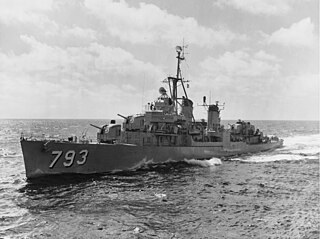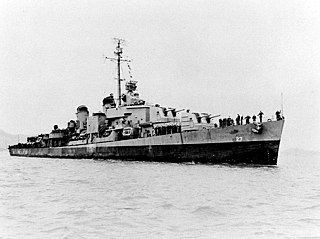
The third ship named USS Aaron Ward (DD-773/DM-34) in honor of Rear Admiral Aaron Ward was a Robert H. Smith-class destroyer minelayer in the service of the United States Navy.

USS Cassin Young (DD-793) is a Fletcher-class destroyer of the U.S. Navy named for Captain Cassin Young (1894–1942), who was awarded the Medal of Honor for his heroism at the Japanese attack on Pearl Harbor and killed in the Naval Battle of Guadalcanal in the fall of 1942.

USS Bache (DD/DDE-470), a Fletcher-class destroyer, was the second ship of the United States Navy of that name. The destroyer was named for Commander George M. Bache.

USS Evans (DD-552), a Fletcher-class destroyer, was the second ship of the United States Navy to be named for Rear Admiral Robley D. Evans (1846–1912).

USS Isherwood (DD-520), a Fletcher-class destroyer, was the second ship of the United States Navy to be named for Rear Admiral Benjamin F. Isherwood (1822–1915).

USS Butler (DD-636), a Gleaves-class destroyer, is the only ship of the United States Navy to be named for Marine Corps Major General Smedley Butler, twice awarded the Medal of Honor.

USS Mannert L. Abele (DD-733), was an Allen M. Sumner-class destroyer of the United States Navy. The destroyer was sunk on April 12, 1945, near Okinawa with 84 casualties. It was the first US warship to be damaged or sunk by the rocket powered Yokosuka MXY7 Ohka suicide flying bomb.

USS Adams (DM-27) was a destroyer minelayer in the United States Navy. She was named for Lieutenant, junior grade Samuel Adams. The other two USS Adams that have existed were named after the second president.

USS Lindsey (DD-771/DM-32/MMD-32) was a Robert H. Smith-class destroyer minelayer in the United States Navy during World War II. She was named for Eugene E. Lindsey.

USS Robert H. Smith (DD-735/DM-23) was the lead ship of her class of destroyer minelayers in the United States Navy.

USS Thomas E. Fraser (DD-736/DM-24) was a Robert H. Smith-class destroyer minelayer in the United States Navy.

USS Harry F. Bauer (DD-738/DM-26/MMD-26) was a Robert H. Smith-class destroyer minelayer in the United States Navy. She was named for Lieutenant Commander Harry F. Bauer (1904–1942).
USS Tekesta (AT-93) was Navajo-class fleet tug built during World War II for the United States Navy. Shortly after being built, it was crewed by trained Navy personnel and sent into the Pacific Ocean to provide tug service to damaged ships in battle areas. For successfully performing this dangerous work, she was awarded four battle stars by the war's end.

USS Riddle (DE-185) was a Cannon-class destroyer escort in service with the United States Navy from 1943 to 1946. In 1950, she was transferred to France where she served as Kabyle (F718) until being decommissioned and scrapped in 1959.

USS LSM(R)-190 was a United States Navy LSM(R)-188-class Landing Ship Medium (Rocket). She was built at Charleston Navy Yard, Charleston, South Carolina and was commissioned on 21 November 1944. LSM(R)-190 took part in the Battle of Okinawa from 7 April–4 May 1945. She was hit and sunk by a Japanese suicide plane on 4 May 1945 while on the radar picket line. She later received a Navy Unit Commendation for her service off Okinawa. Her commanding officer was Lt. Richard H. Saunders, USNR.
LSM(R)-193 was an American Landing Ship Medium (Rocket) built in 1944, which provided naval gunfire and rocket support for US and Allied amphibious landings in World War II. It was laid down at Charleston Navy Yard and commissioned on 21 November 1944. It participated in the Battle of Okinawa as well as the run-up to the battle
LSM(R)-192 was a LSM(R)-188 class Landing Ship Medium (Rocket) of the US Navy during World War II. Laid down at Charleston Navy Yard, Charleston, South Carolina, the ship was commissioned on 21 November 1944, Lt. (jg) Neal B. Hadsell, USNR, in command.

USS LSM(R)-194 was a LSM(R)-188-class Landing Ship Medium (Rocket) of the United States Navy during World War II, which took part in the Battle of Okinawa. LSM(R)-194 was laid down at the Charleston Navy Yard, Charleston, South Carolina on 21 November 1944. The ship was under the command of Lt.jg Allen M. Hirshberg, USNR. It sank on 4 May 1945 when it was hit by a Japanese suicide plane while on radar picket duty.

LSM(R)-196 was a US amphibious assault ship, laid down at Charleston Navy Yard. It was commissioned on 12 December 1944, Lt. Dennis D. O'Callaghan, USNR, in command.

LSM(R)-195 was laid down at Charleston Navy Yard. The ship was commissioned on 21 November 1944, Lt.(j.g.) William E. Woodson, USNR, in command

















